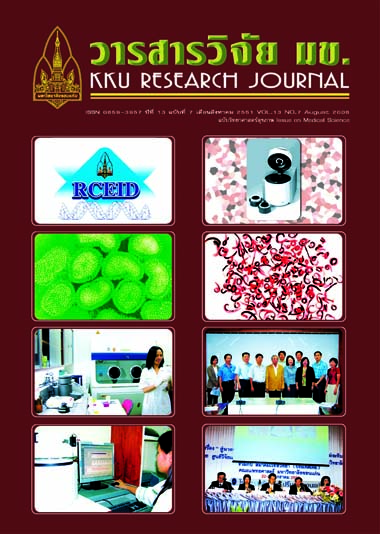A prognostic model to predict the immediate results of radiation on cervical cancer (Thai)
Main Article Content
Abstract
Cancer of the cervix uteri is still the most common cancer among Thai women. Currently, the best
treatment for locally advanced disease, and an apparent cure in some cases, is radiation treatment. This study
attempted to develop and validate a simple tool to predict the immediate result of radiation on cervical cancer.
Cases of cervical cancer, based on radiation treatment data, were retrieved from the database of the Radio-
therapy Unit. Retrospective data from between January 3, 1994, and December 30, 2003, yielded 1,323
cervical cancers after radiation treatment. These data were used to drive the model. Later, prospective data
were collected from 74 cervical cancers between January 19, 2004 and December 23, 2005, to validate the
model using Multiple Logistic Regression. The model was well-calibrated (i.e., the goodness-of-fit test, p-
value= 0.12) and had fair discrimination (i.e., the area under the receiver-operating characteristics [ROC]
curve=0.63 (95% CI: 60.0-66.0)). Performance in the validating sample was fair with area under the ROC
curve=0.61 (95% CI: 58.0-64.0) and goodness-of-fit test, p-value= 0.77. When applied to the validation
set using a cut-off point of p>0.22 to designate curableness of the cervical cancer by radiation, the model had
respective sensitivity, specificity, positive predictive value and negative predictive value of 78.6 (95% CI:
64.7-88.7), 43.2 (95% CI: 29.3-58.8), 34.0 (95% CI: 20.8-47.9) and 84.2 (95% CI: 71.4- 930).
The results of this study demonstrate the simplicity of the tool and its fair predictive power which might be
useful when doing clinical assessments.
treatment for locally advanced disease, and an apparent cure in some cases, is radiation treatment. This study
attempted to develop and validate a simple tool to predict the immediate result of radiation on cervical cancer.
Cases of cervical cancer, based on radiation treatment data, were retrieved from the database of the Radio-
therapy Unit. Retrospective data from between January 3, 1994, and December 30, 2003, yielded 1,323
cervical cancers after radiation treatment. These data were used to drive the model. Later, prospective data
were collected from 74 cervical cancers between January 19, 2004 and December 23, 2005, to validate the
model using Multiple Logistic Regression. The model was well-calibrated (i.e., the goodness-of-fit test, p-
value= 0.12) and had fair discrimination (i.e., the area under the receiver-operating characteristics [ROC]
curve=0.63 (95% CI: 60.0-66.0)). Performance in the validating sample was fair with area under the ROC
curve=0.61 (95% CI: 58.0-64.0) and goodness-of-fit test, p-value= 0.77. When applied to the validation
set using a cut-off point of p>0.22 to designate curableness of the cervical cancer by radiation, the model had
respective sensitivity, specificity, positive predictive value and negative predictive value of 78.6 (95% CI:
64.7-88.7), 43.2 (95% CI: 29.3-58.8), 34.0 (95% CI: 20.8-47.9) and 84.2 (95% CI: 71.4- 930).
The results of this study demonstrate the simplicity of the tool and its fair predictive power which might be
useful when doing clinical assessments.
Article Details
How to Cite
Kamsa-ard, S., Tangvorapongcha, V., Krusun, S., Sriamporn, S., Suwanrungruang, K., Mahaweerawat, S., & Pomros, P. (2017). A prognostic model to predict the immediate results of radiation on cervical cancer (Thai). Asia-Pacific Journal of Science and Technology, 13(7), 851–865. retrieved from https://so01.tci-thaijo.org/index.php/APST/article/view/83653
Section
Research Articles
References
-

